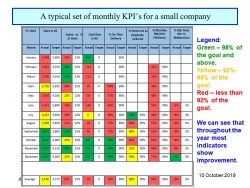Brainstorming is one of the basic tools in the development of ideas, problem-solving, creative thinking or any other group endeavor.
For example, when we develop Fishbone with the objective of arriving at the root cause of a specific problem, or while we are constructing a flowchart of a specific process, brainstorming is the basic tool we should use.
Advantages of Brainstorming
First of all, brainstorming is inherently a collaborative effort, involving a number of people. It is true that a group can usually come up with more ideas and new ways of thinking; however, it isn't always the quantity of ideas that interest us but rather the swifter manner in which we can generate new and creative solutions.
How do we do it?
- The Forum. Brainstorming is suitable for any team or group that meets regularly (beginning with management and including improvement teams or any other ad hoc teams; however, if you are constructing a specific team for this purpose, it is recommended that members be diversified and from different fields of activity, to attain a rich and expansive variety of ideas.
- In writing. When engaging in brainstorming and ideas arise in discussion, there is always the risk that one of the ideas will dominate the stage and prevent additional ideas. Therefore, in the first stage, everyone makes a private list of as many ideas as possible.
- Collecting ideas. In the next stage, after everyone has made a list, all the ideas are listed on a central blackboard. To keep everyone involved in the discussion, each person will present one idea, going around again and again until all the ideas have been presented.
- Without comments. Our natural instinct is to comment on each idea that arises. Here, however, we will again lose the potential of adding more and more ideas. Even if something similar has already been suggested, no editing or combination of ideas will be offered during collection and listing of the ideas on the board. Only after all the ideas have been listed will we examine them and see if there is room to combine or edit what we've listed.
- Summary. Now we will examine the results and chances are we will have many subjects and ideas to address.
Prioritization and Filtering
In the last stage of our brainstorming, we may sometimes often wish to allocate priority for handling or sort and filter out in order to end up with a smaller list of ideas. Sometimes this last stage of prioritization and filtering is handed over to a very small team of 2 or 3 management positions.
I recommend the point system: each of the participants selects three to five ideas and the idea with the highest priority is granted 3 points (where each person chooses 3 ideas, or 5 points, according to the number of ideas they select). The next idea receives 1 point less, and so on.
Now, if we add up the points, we will have an easy way to prioritize the ideas in a manner which expresses the team's attitude.
Surprisingly, in most cases there will be few ideas that are granted a lot of points and rise to the top of the list.
Summary and recommendations:
At first glance, this method appears to render the thinking process awkward and troublesome. However, if you work according to this method, you will find that it actually shortens the time for suggesting ideas and greatly benefits the results.
GOOD LUCK!












 My First Book: Manage! Best Value Practices for Effective Management
My First Book: Manage! Best Value Practices for Effective Management